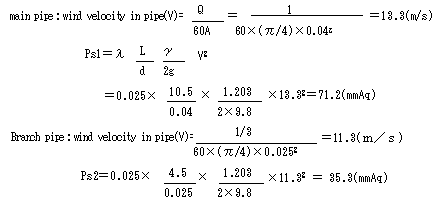Vortex Blower model Selection
Guide
Hitachi Industrial Equipment Systems Co., Ltd.
Wind water system division
Vortex Blower model Selection
(Example)
1).Pneumatic conveying
To select a blower for pneumatic
conveying, the following conditions should be considered.
|
|
|


|
� |
wind quantity required (Q) |
|
� |
Wind velocity required (��) |
|
� |
Pipe Diameter(d) |
|
� |
Necessary stillness pressure(Ps) |
According
to the above calculation, from the discharge character of the characteristic
curve of the blower, a VB-040-E2 * 1 unit should be selected in the case of
50Hz.
|
[Notice] |
||
|
� |
The establishment of the rotary valve and the obstacle board is necessary for the sake of "avoiding putting much conveyed material in the pipeline.", and " preventing the countercurrent of the air to the supply tank(in the case of discharge) " |
|
|
|
|
|
|
[Others] |
|
|
� |
Compressor, Roots Blower and Turbo Blower
could be used instead of Vortex Blower in the case of the pneumatic
conveying. |
|
2). |
Scrap collection |
|
|
|
|
Physical object�Fcasting
powder(powder-shaped thing) |
<Pipeline diagram>


�Necessary stillness pressure(Ps)

|
|
Take a redundancy of 20%. |
According to the above
calculation, from the induction character of the characteristic
curve of the blower, a VB�|030�|E2 * 1 unit is selected in case of 60Hz.
|
[Notice] |
|
|
� |
It's possible that the scrap can't be sucked in to the pipe if the space between the scrap material and the suction mouth is far away. In principle, you should make the scrap touches the suction mouth, or let the scrap drop to the mouth. |
|
� |
A collection tank is necessary because the collected scrap can't be put into the blower directly. A filter (change its eye size corresponding to the size of the scrap) must be set in the tank. It is better to set anther filter (VBLF type) between the blower and the tank as well. |
|
� |
It's better to put a drawer-type box in the collection tank for the sake of convenience when the collected scrap is to be abandoned. Leave no gap between the drawer and the body of the collection tank to avoid the leakage of the collected scrap. |
|
|
|
|
[Others] |
|
|
� |
For scrap collection the method of discharging by blowing can be used too(used as a secondary pressure source). |
|
|
|
|
In this case, the effective ability of the blower is computed by a factor of about 1/3. |
|
3).Suction carriage
To select a blower for suction
carriage, the following conditions should be considered.
![]()

<Pipeline diagram>

�ENecessary stillness pressure(Ps)

According to the above calculation, from the induction character(under
the completely
closed pressure) of the characteristic curve of the blower, a VB-015-G * 1 unit
should be
selected in the case of 50Hz.



|
[Others] |
|
|
� |
In the case of suction carriage, except the Vortex Blower, the vacuum pump, the second pressure using of compressor, can also be considered too. |
|
� |
If using the vacuum pump or the compressor, dropping of the adsorbed object may occur because of air leakage, so the blower is favorable. |
4).Blowing off
To select a blower for blowing off,
the following conditions should be considered.
![]()
[Calculation example]
Used for the water drops removal on the washed steel board.

<Pipeline diagram>

|
� |
Wind velocity required (��) |
|
� |
Wind quantity required (Q) |
|
� |
Stillness pressure required (Ps) |
According to the above calculation, from the discharge character of the
characteristic
curve of the blower,a
VB-020-E2 * 1 unit is selected in the case of 60Hz.
|
[Notice] |
|
|
� |
It's better to draw a nozzle to the working object as close as possible, since the speed of air from the nozzle goes down due to the diffusion. Because of this fact, it's necessary to conduct a test beforehand to confirm your selection. |
|
� |
Increasing the air speed in the nozzle causes the noise in the nozzle becomes loud.(Generally the noise is louder than that of the blower). To decrease the noise, it can be covered with a soundproof box. Or lower the noise by decreasing the air speed. Because down the air speed is a countermeasure to the purpose primarily set, it's not a good way to do it. |
|
|
|
|
[Others] |
|
|
� |
Though compressor can be used for blowing off, but because its wind amount is not enough in this case, only limited area can be blown off, a blower is more favorable for the area it can cover to blow off is larger. |
|
� |
The slit breadth of the nozzle which is suitable for the blower is about 0.5-2 �o. If the width beyond 2 �o, the required wind quantity grows big, and then it's not suitable. |
5).Aeration
To select a blower for aeration in
water, the following conditions should be considered.
![]()

<Pipeline diagram>

|
� |
Wind quantity required (Q) |
|
� |
Necessary stillness pressure(Ps) |
|
[Notice] |
|||||
|
� |
In the case of aeration, except the culture pond, the necessary wind quantity is often not specified clearly. A rough standard from experience is shown in the following.
|
||||
|
� |
Special attention must be paid to this fact that, in the case of aeration, if no place of the blower or the pipe is higher than the surface of the water, water may flows into the blower backward. |
||||
|
� |
Check valve can be used for preventing countercurrent of water, but if the water pressure doesn't reach about 10m, the valve may not be closed tightly then water may leak out. |
||||












